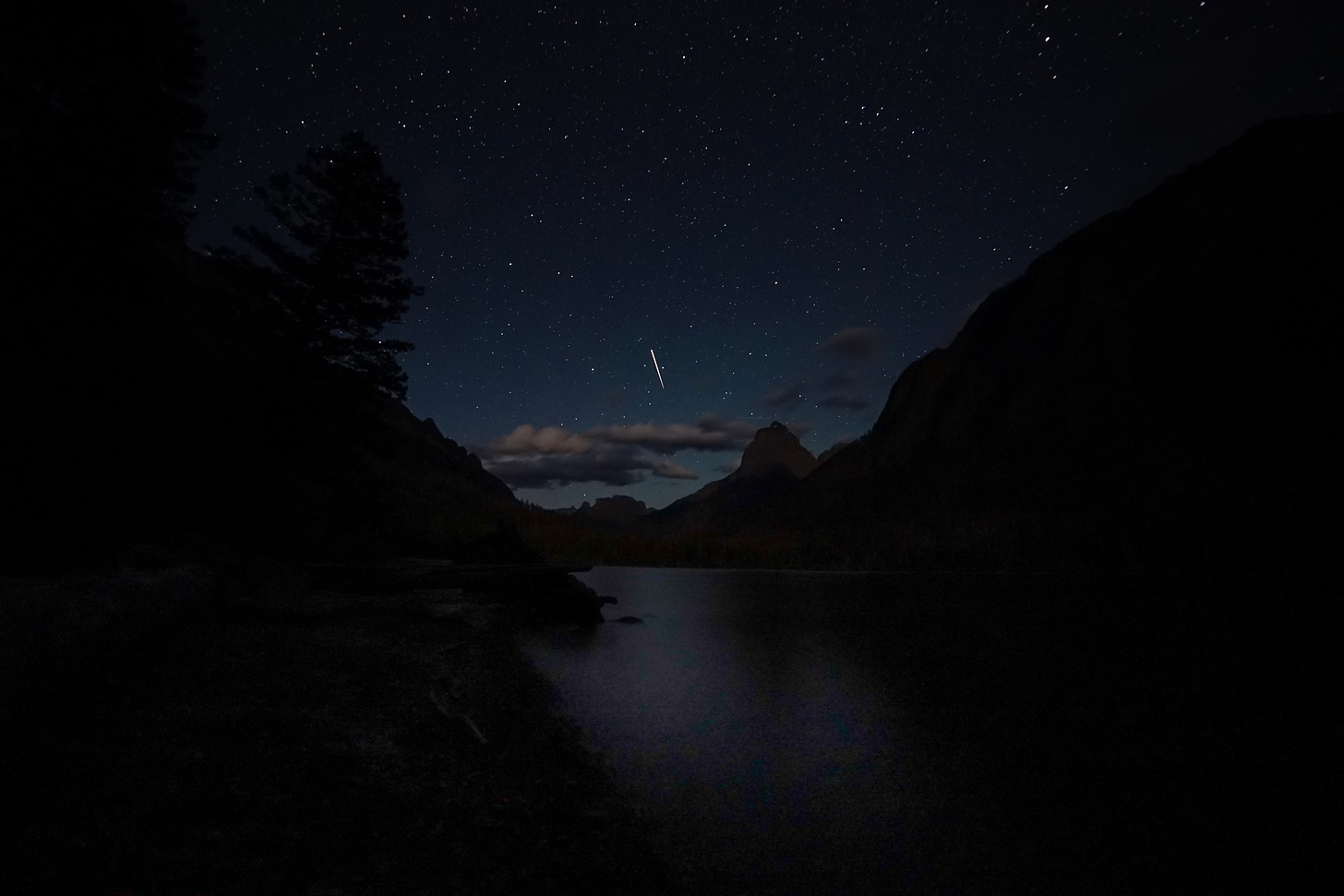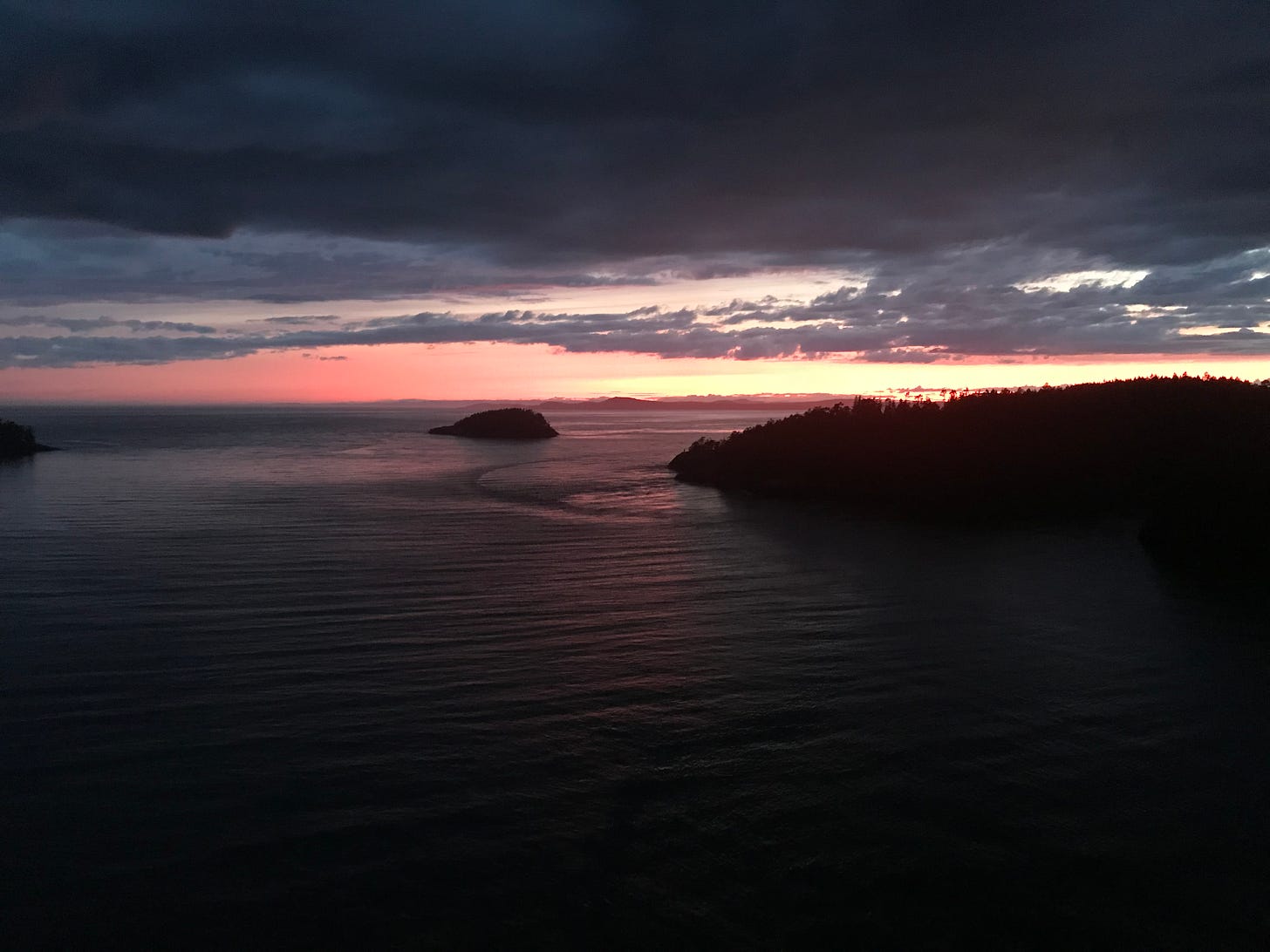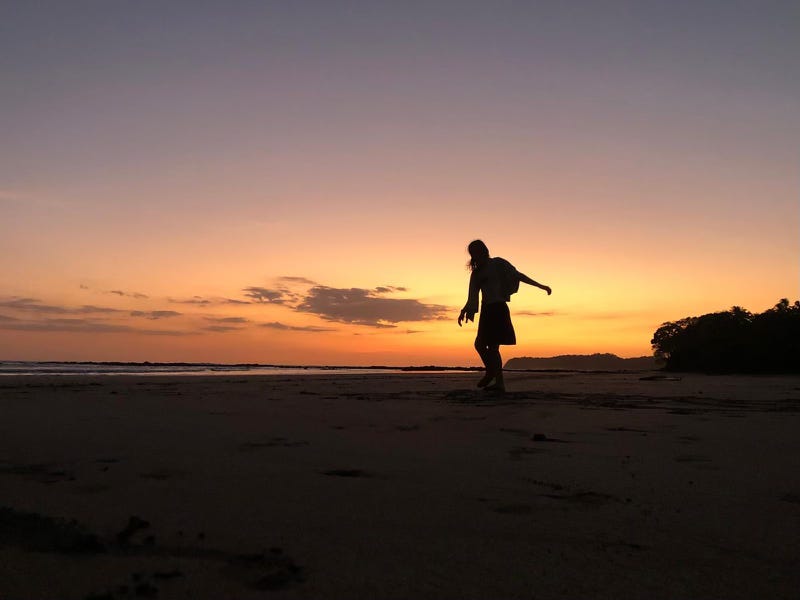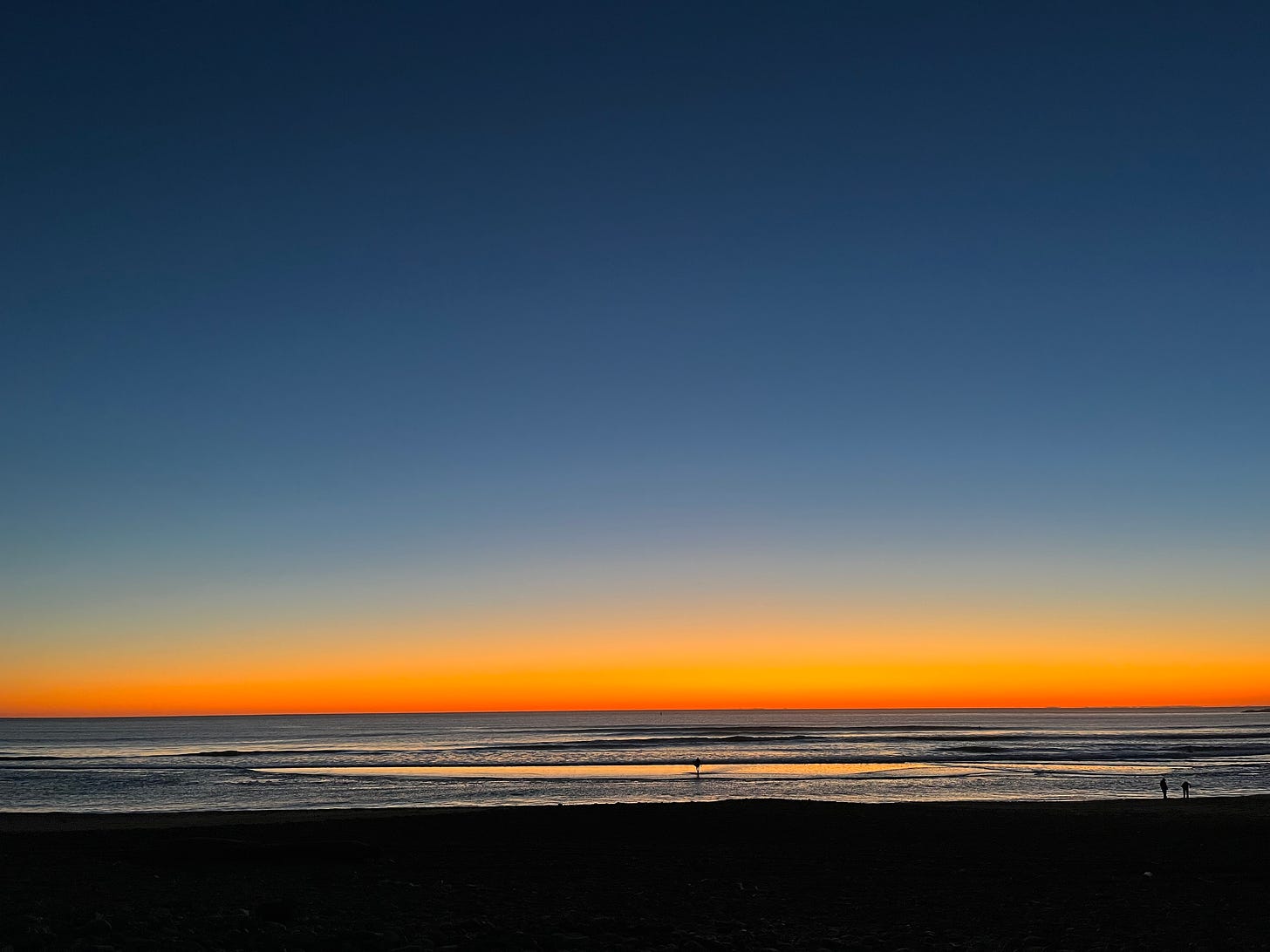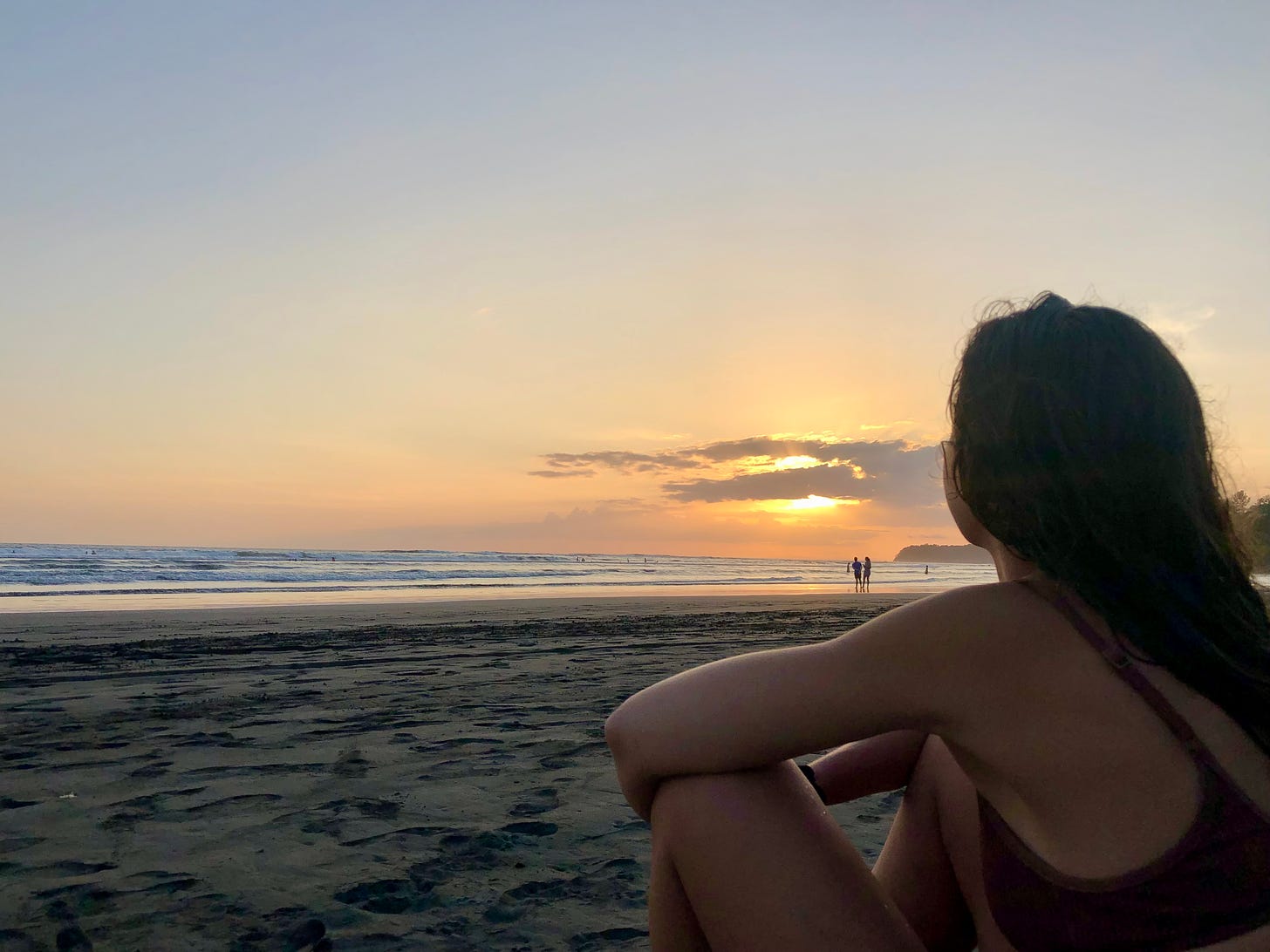Dear readers—
I write to you from the tropics yet again, this time a few degrees closer to the equator. I’m in Panamá, and I write this newsletter to you from a string of different settings—a balcony within a town within a volcanic crater, a best friend’s couch in a high-rise in Panama City, a kitchen table in little surf shack near the beach.1 A sweet dog rests beneath me, dreaming, her leg twitching while she sleeps.
Since we last spoke (Does this feel like conversation to you too?), I’ve traveled back north to Washington state, spending time with loved ones in the Snoqualmie foothills and settling in back home on the North Olympic Coast. It took about three days for my sun-soaked cells to acclimate to the unusually “warm” 40-degree winter we were having. It took about a week to lose my tan. As the melanin waned, I replenished the warmth with soaks in snowy hot springs, copious amounts of herbal teas, and waking up in my Love’s arms once again.
While it’s validating to be reminded that I’ve structured my life in alignment with when and where my body feels best (i.e. flying south in the winter), I’m grateful to have snuck back home for a couple of weeks. I’m grateful that Winter let me see Her. It felt like a parent checking in on their sleeping child when they got home from date night—quietly opening the bedroom door, watching in the dark for a few awe-filled moments, then quietly slipping out once more.
The child,
in this case,
being:
the three baby plum trees I planted last spring,
the evergreen clematis climbing up the front porch,
the homemade apple wine racking in the cupboard.
Even in the deepest quietude of winter, the abundance is ceaseless.
Usnea lichen dangles from barren branches at the beach, tickling the air with medicine.
Thick mats of soggy, decaying maple leaves
protect and nourish the garden.
Bulbous rosehips brighten thorny thickets,
brimming with juice for the birds and me.
Chanterelles dance from damp forest floors before
making their way to my dinner plate.
I walk within the woods
whispering
thank you.
Everything holding
a do-not-disturb sign.
Inside, I ponder winter’s way
while the low hanging sun does its best to reach inside my home,
but misses.
I witness
the moonrise
from my perch at my office desk.
Her silver light infinitely more illuminating
than a screen,
Her softness
infinitely stronger than a machine.
And then, without much notice or grandeur,
arrives the most striking aspect of winter,
the subject of this newsletter,
the intangible,
impenetrable,
Dark.
The darkness of the Olympic Peninsula is all-consuming. It is something better observed than described.
It swallows everything in its path with an opaqueness blacker than ink. Long stretches of road unfold for miles without a street light, wrapping around a million acre wild interior.
I know we all experience the night,
but I promise you—
this is different.
The sun rises at 8:00am and sets by 4:30pm at the peak of the winter solstice—16 hours of darkness a day.
And just as I wrote to you in June in Light will always cast a shadow, I say to you in January from 180-degrees later—Shadows will always need the light.
They are two halves of the same whole,
incapable of existing without the other,
turning, churning, twirling in close embrace.
“Darkness
Gives shape to the light
As light
Shapes the darkness.
Death
Gives shape to life
As life
Shapes death.
The universe
And God
Share this wholeness,
Each
Defining the other.
God
Gives shape to the universe
As the universe
Shapes God.”From EARTHSEED: The Books of the Living
– Octavia E. Butler, Parable of the Talents
Dear reader, the Dark has so much to teach us about Life, and light.
Take nocturnal animals. These creatures have adapted and successfully survived by conducting their living under the protection of the night. To see, they’ve evolved larger eyeballs, pupils that dilate to enormous size, a superabundance of rod cells2, and an additional reflective layer of the eye called the tapetum lucidum, which sends light back to the retina. Heightened senses of hearing and smell assist them in navigating and hunting in the dark.
The owl has the best night vision in the entire animal kingdom. One reason for this is that owls have a million rods per square millimeter in their eyes, five times denser than humans’. To put that in perspective—an owl spotting its prey is equivalent to if a human could spot a mouse a mile away by the light of a single match.
And the octopus. My God—literally—the octopus. Octopus are generally nocturnal creatures, and I will never forget the first time I saw one while on a night dive, my body suspended in complete reverence as its body parachuted, contracted, ballooned, and iridescently dazzled across a coral outcropping. Once our flashlights moved away, the pitch-black ocean filled the space once again, as if we were never there. I wondered how the octopus could see through the closed curtain of the dark.
I tried Googling this and learned some new facts, like how octopus are colorblind, have polarized vision, an eye that focuses like a camera lens, that they contain light receptors in their skin (!!!), and that they hunt by searching for small flickers of light, which resemble their prey. I still don’t understand how they see in the absence of light—but perhaps there never really is.
Now I’m thinking of creatures who truly live in total darkness. Neither nocturnal nor diurnal, they simply exist in the void. What might they teach us about seeing in the dark?
I’m thinking of earthworms, beloved earthworms who aerate and decompose and instill joy in every gardener who finds them in their soil—a wriggly sign that something is going right. Earthworms, beloved earthworms, who live entirely beneath the surface and thus have no need for eyes. Did you know that their skin, like the octopus, contains light receptors too?
But why?
They can sense
when they’re in the light
so they can tell
if they’ve above ground
so they can know
if they’re at risk
of predators, be it bird
or blazing sun.
Dear reader, I fear I may be drying out,
having writhed from the dark too soon,
and having stayed there too long.
Old patterns of doing everything at all once
come knocking once more, and I wish
I had eight limbs to hold it all.
I see the cycle approaching and try to stop it,
as an owl could from a mile away, but the gravitational
pull has already begun its turn.
Perhaps I could not catch it because
I forgot I could see with my skin.
Do we feel it or see it coming?
Are they one and the same?
All I know is I cannot feel with my eyes.
Dear reader, I want to write to you from a depth
within myself that I am struggling to access
with the scraps of time available to me.
I look nowhere else than in the mirror,
and say, with grace,
“Since when did time become a barrier to accessing You?”
“Quiet friend who has come so far,
feel how your breathing makes more space around you.
Let this darkness be a bell tower
and you the bell. As you ring,what batters you becomes your strength.
Move back and forth into the change……in this uncontainable night,
be the mystery at the crossroads of your senses,
the meaning discovered there...”– Rainier Maria Rilke, excerpt from Sonnets to Orpheus II, 29
Dear reader, there’s one last thing I want to share about seeing in the dark:
Nothing comes into being without vision, without the ability to see that which is not yet there. And ironically, we need our eyes both open and closed to do so.
We must be wide awake to the world—witnessing, withstanding, vigilant and original in our thought and our questioning. Then we must close our eyes to imagine the world we want instead.
It is not the other way around.
We do not close our eyes to that which we do not wish to see.
I’m grateful to be diving back into the work of Octavia E. Butler, among the most celebrated writers in the realm of visionary fiction. Her dystopian yet hopeful Parables series, the first of which she wrote in 1993, takes place roughly between 2015–2030. They are terrifyingly accurate to the social, economic, and environmental crises we find ourselves in, and hurling deeper into, today. Many have asked her about her prophetic abilities, to which she’s replied:
“All I did was look around at the problems we’re neglecting now and give them about 30 years to grow into full-fledged disasters...writing novels about the future doesn’t give me any special ability to foretell the future. But it does encourage me to use our past and present behaviors as guides to the kind of world we seem to be creating.” – Octavia E. Butler, Essence Magazine, May 2000
Dear reader, we are living inside the vision of a group of people who believed that endless extraction and shoving heads in the sand were an acceptable approach to the future. Who imagined superiority and domination as rightful structures. Who accepted mass suffering and disparity as a reasonable trade for their power.
We are living inside it, but we are not stuck inside it. We can imagine, write, organize, elect, dismantle, and rebuild our way out.
As adrienne marie brown shares in Emergent Strategy, “All organizing is science fiction.”
May we always move toward the kinder and kind of future that is not yet there, but that we all see in our heart’s and mind’s eye.
May we turn to the visionaries like Octavia who could witness humanity in its deepest darkness, yet always find the glimmers of light. Who used these sparks, however sparse, to write, and light, a new way forward.
May the Spirit of Creation bless us all with night vision.
Dear reader, to honor the flow of the season and the limits of my current capacity, I will not be writing a REPRISE issue for January. I thank you for your understanding and invite you to spend time with Octavia’s work. She has left us with an absolute treasure trove.
Until next time, with deep love,
Iz.
These newsletters take multiple days to produce, even more so with a raging day job, living out of a backpack in Latin America, fighting off infections, and tending to the many necessities that being a human, relational creature requires.
In case you need an anatomy refresher (I did), rods interpret light, cones interpret color.





